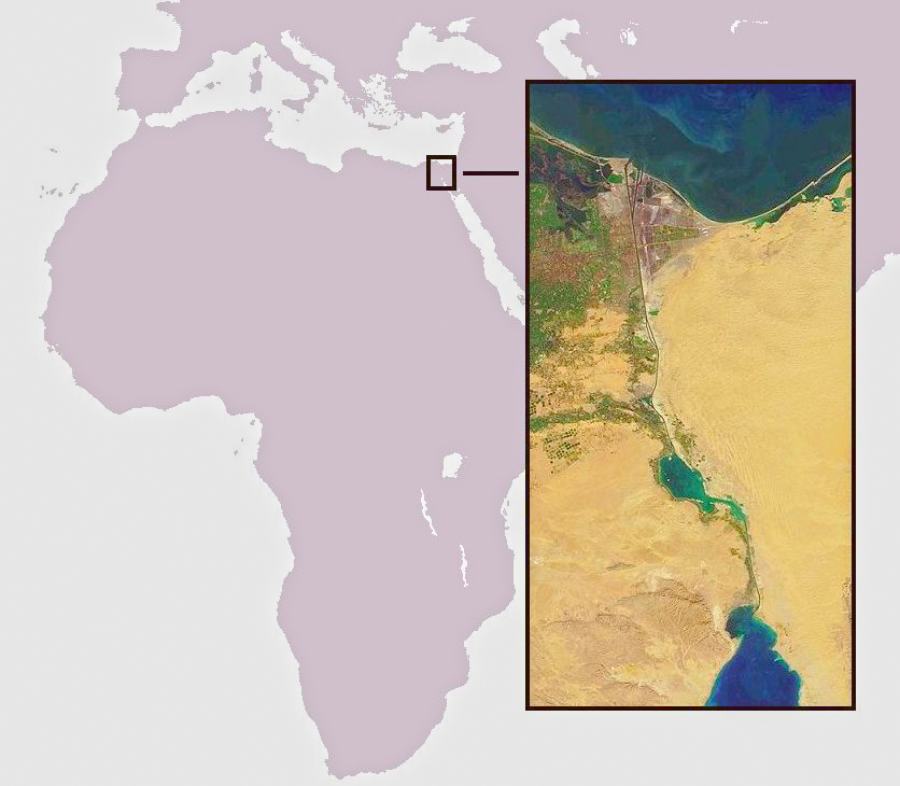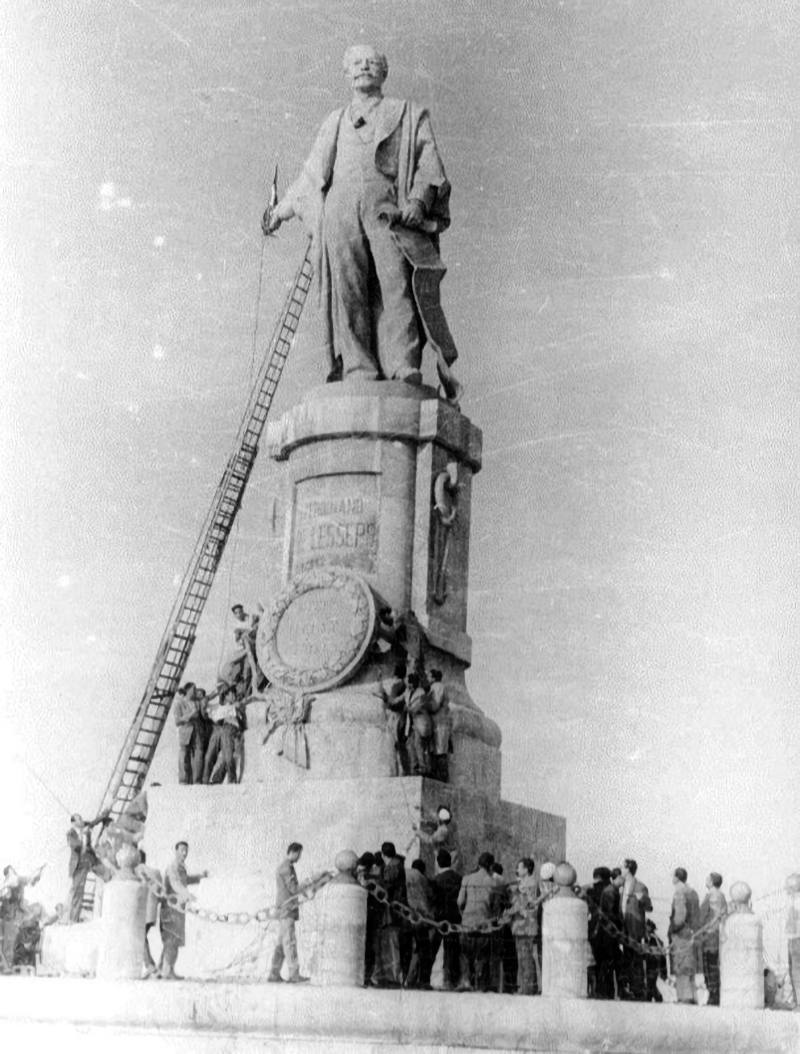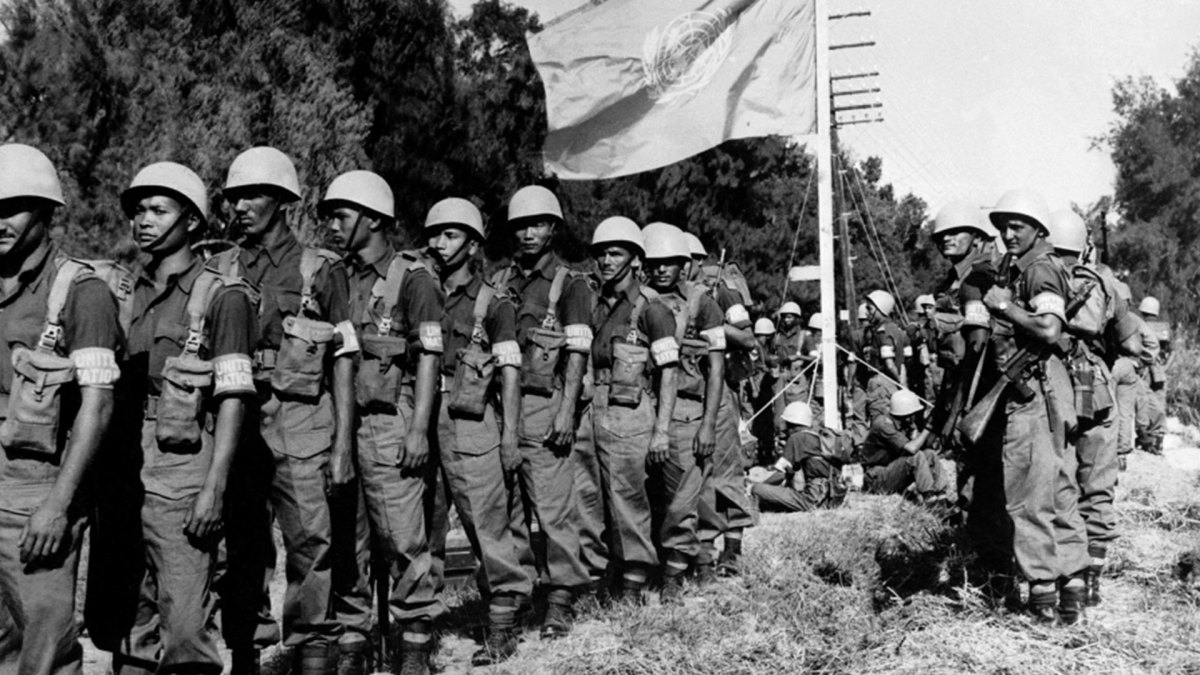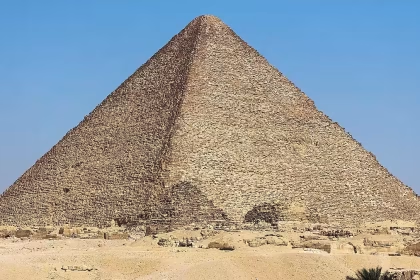The Suez Canal, opened in Egypt in 1869, is a vital sea route that connects the Mediterranean Sea with the Red Sea and, by extension, the Indian Ocean. The Universal Canal Company was nationalized by Egyptian President Nasser, prompting immediate responses. The United Kingdom, France, and Israel, three allies, launched a military battle against Egypt. The United States and the Soviet Union, the world’s two superpowers at the time, stepped in quickly amid heightened tensions. Thus, the worldwide Suez crisis occurred in a very specific setting, characterized by the interplay of the Cold War, the Arab-Israeli disputes, and the end of colonialism.
The construction of the Suez Canal and British domination

Since the late 18th century, people had been planning to create a waterway that would connect the Mediterranean and the Red Seas. In the middle of the 19th century, Ferdinand de Lesseps took it up. The former Consul General of Alexandria used his personal relationship with Sa’id of Egypt, now Viceroy of Egypt, to further his agenda.
He negotiated his way into a 99-year lease. In 1858, he established the Compagnie universelle du canal maritime de Suez (Universal Company of the Maritime Canal of Suez) to finish building the canal. The United Kingdom, however, was quick to reject the operation out of concern for its economic superiority along the route to India.
Even though it halted work for three years, it ultimately failed to thwart the success of the project. On November 17, 1869, the Suez Canal opened to the public. It stretched for a total of 162 kilometers and would facilitate increased shipping activity. The economic potential of this sea route between Europe and Asia was rapidly recognized in the United Kingdom. After purchasing the Egyptian stock, it became the company’s single-largest shareholder. The United Kingdom gradually consolidated its control over the nation by planting soldiers in key locations.
The nationalization of the Suez Canal

Since the 1880s, Egypt had been experiencing a growing sense of nationalism that eventually led to the country’s proclamation of independence. Upon signing a treaty with Britain in 1936, the latter withdrew its occupying forces from the country, with the exception of those stationed in and around the Suez Canal. Therefore, Britain maintained its sway over the seaway by making its defense a top priority. This intrusive presence was not well received by Egyptians, and King Farouk I’s popularity plummeted. In addition, the Arab-Israeli conflict broke out in 1948, further destabilizing the region. Despite the armistice, hostilities persisted.
Gamal Abdel Nasser took control of Egypt when the monarchy was overthrown, and in 1954 he successfully negotiated the British evacuation of all of their soldiers from the country. Simultaneously, the Egyptian president planned the Aswan Dam’s construction and asked the United States for funding. After being turned down by the British and the French, he nationalized the Suez Canal’s Universal Company on July 26, 1956.
The unexpectedness hit like a brick. The United Kingdom swiftly responded. Anthony Eden, the country’s prime minister, regarded this as a danger to commerce and the economy. Very soon, he was able to win over France, whose patience with Nasser’s advocacy of Algerian nationalists had worn thin. Meanwhile, American President Dwight Eisenhower steadfastly declined to join the battle.
The Suez crisis
While Eisenhower sought a diplomatic resolution, British and French representatives, together with representatives from Israel, met in private in Sevres. The three countries then devised an offensive strategy, which called for Israel to invade Egypt, whose forces were already engaged in combat on the border.
Two others would step in, claiming to be guarding the canal. And thus, on October 29, 1956, the Israeli army entered Sinai as planned. The French and British quickly issued a demand for the warring parties to get out of the canal zones. Nasser’s refusal was anticipated and exploited as justification for involvement by France and Britain.
Eisenhower was caught off guard by this involvement and attempted to take swift action. He was quite concerned that the Arab governments, in the middle of the Cold War, might start looking to the Soviet Union for help. The US president asked the UN to approve a resolution ordering a ceasefire because of this.
Despite this, Franco-British forces massed along the canal. When the Soviet Union’s forces were still stationed in Egypt, it threatened to launch rockets at the nations involved. The “two great ones” decided to stop their battle despite the pressures that opposed them, especially in light of the happenings in Hungary.
The aftermath of the Suez crisis
With the use of economic and political penalties, the United Nations was able to get Great Britain to comply with its decision. The French government was forced to agree to the ceasefire. Both countries felt humiliated by the loss and withdrew their forces from the zone under UNEF (United Nations Emergency Force) supervision by December.
Nasser, on the other hand, was becoming more well-liked among Muslims. Brief though it was, the Suez Canal crisis was indicative of broader underlying conflicts. Relations between the United States and the Soviet Union remained tight in the midst of the Cold War, which had been ongoing since 1946. It was impossible for the European nations, who were losing ground in the Middle East, to challenge the “big two.” Finally, the incident did little except reignite tensions between Israelis and Arabs, which eventually led to the Six-Day War.
TIMELINE OF THE SUEZ CRISIS
November 30, 1854: Ferdinand de Lesseps was granted the concession for the Suez Canal
The Viceroy of Egypt, Mohamed Sa’id Pasha (Sa’id of Egypt), granted Ferdinand de Lesseps a 99-year concession to construct the Suez Canal. The French businessman’s goal was to establish a sea connection between the Mediterranean and the Red Sea. When the current concession ended, Egypt would take full ownership of the canal.
Ferdinand de Lesseps established the Compagnie universelle du canal maritime de Suez to handle the project’s finances and construction. The Suez Canal opened to much fanfare in 1869, despite difficulties with the British. This massive, 162 km-long project took 10 years to complete.
November 17, 1869: Inauguration of the Suez Canal
The opening of the Suez Canal in the 19th century and the Panama Canal in 1914 both contributed to the growth of marine traffic. Empress Eugenie, wife of Napoleon III, Prince of Prussia, Emperor of Austria Franz Joseph, and an English envoy attended the opening of the Suez Canal on November 17, 1869. Roughly forty ships made the journey via the canal’s 162 kilometer length on this particular occasion.
October 29, 1888: Internationalization of the Suez Canal
The Suez Canal became part of the international system thanks to a treaty signed in Constantinople (İstanbul) by various nations, including England. It was thus available for use by any ship, of any country, during both peace and conflict. However, this rule was not always adhered to in the years after 1875, especially during World Wars I and II, when England controlled the lion’s share of the Canal Company’s shares.
February 28, 1922: End of the English protectorate over Egypt
When the Egyptian independence movement became too strong to ignore, the British government declared that the protectorate it had created over Egypt in 1914 was officially terminated. Since 1882, Great Britain was effectively ruling the region. In spite of achieving independence, the nation still had very little control over its own affairs.
Indeed, the British monarch retained exclusive control over matters like Suez Canal security, military matters, and the safeguarding of foreign interests. Once the protectorate was abolished, Egypt became a monarchy, and Sultan Fouad I anointed himself king. However, it wasn’t really independent until an agreement was reached between France and Egypt in 1936.
August 26, 1936: Britain recognizes the independence of Egypt
In effect, as a result of the signing of an agreement between Britain and Egypt, Egypt became a sovereign nation. Egypt had become a monarchy by the time the British protectorate ended in 1922, having been formed in 1914. On the other hand, Britain maintained control over the country’s military and diplomatic affairs. As a result, its forces maintained a significant presence over most of the country. The signature of this pact required them to depart the nation, with the exception of the Suez Canal. In 1953, after the “free officers” coup d’état led by Neguib and Nasser, the Republic was declared.
23 July 1952: Overthrow of the Egyptian monarchy
The secretive group known only as “the free officers” ousted King Farouk in the middle of the night. Mohamed Neguib, a general, was named president after the proclamation of the Republic. Since the conclusion of the first Arab-Israeli war (1948–49), Egypt had been in a state of crisis. The monarch was blamed for Israel’s victory, and his capitulation to the British, who had established themselves on the Suez Canal, startled the country’s many political currents.
Young Colonel Gamal Abdel Nasser, who later became Deputy Prime Minister, launched the progressive movement that toppled him. On July 26, King Farouk abdicated and fled to exile in Monaco. The military leader, General Mohamed Neguib, was elected president.
18 June 1953: Proclamation of the Republic of Egypt
Egypt became a republic after the “free officers” secret society staged a coup d’état the previous year to remove King Farouk. Mohamed Neguib, a general, was elected president. However, he was fired in November 1954 when he had a conflict with Lieutenant Colonel Gamal Abdel Nasser. After then, all authority was given to Nasser. With the treaty of departure of the Suez Canal Zone in June 1956, he ended the British occupation of Egypt (which had started in 1882).
June 1956: The British fleet leaves the Suez Canal
When the final British warship exited the Suez Canal, Egyptian President Gamal Abdel Nasser was able to celebrate. Since the collapse of the monarchy in 1952, Egyptians had been calling for the withdrawal of foreign forces. The British and Egyptian governments reached an agreement to completely evacuate the territory in 1954. Nasser declared the canal to be state-owned after its liberation. That way, the Aswan Dam could be built, he hoped. A serious crisis on a global scale was precipitated by the occurrence.
July 26, 1956: Nasser nationalizes the Suez Canal
When Egyptian President Gamal Abdel Nasser visited Alexandria to mark the 5th anniversary of the revolution, he made public his plans to nationalize the Suez Canal and seize the assets of the Universal Suez Canal Company. After the United Kingdom and the United States declined to contribute to funding the Aswan Dam, he made the decision to go on with the project on his own.
France and England were charging passage fees on this waterway between the Mediterranean and the Red Sea, and the “Rais'” response sparked a global crisis. Israel was the first to react, attacking Egypt on October 29; the United Kingdom and France followed suit by sending soldiers. The United Nations succeeded in ending hostilities by having Western soldiers leave the canal’s perimeter. Nasser was able to emerge from the political crisis in a stronger position.
October 22, 1956: An alliance was formed against Egypt
Upon hearing of Egyptian President Nasser’s declaration that the Suez Canal be nationalized, representatives from the United Kingdom, France, and Israel gathered in a secret location in Sèvres to discuss a response. The different delegates reached a consensus on a coordinated action in Egypt to take the canal. The interests of the three countries were distinct. Britain, which had ruled and controlled Suez for decades, was worried about the impact of nationalization on the British economy.
Since Egypt’s ruler backed Algerian nationalists in their fight against French colonialism, France interfered to remove him from office. To that purpose, Israel wanted Egypt to relinquish its occupation of the Gaza Strip. Two days of planning and deliberation resulted in the launch of the strike on October 29. As planned, Israel would attack the Sinai Peninsula. France and Britain then sent soldiers under the guise of protecting strategic canal locations.
October 29, 1956: Israel attacks Egypt
Britain, France, and Israel’s covert partnership had begun its operation a few days earlier. Israeli soldiers invaded Sinai as planned. The other two nations stepped up and offered to deploy troops to guard the canal against the Egyptian president. Nasser, however, would have none of this invasion and hence refused. French and British paratroopers dropped from the sky and soon invaded Egypt thereafter. Key objectives were Port Said and Fuad.
October 31, 1956: Franco-British intervention against Egypt
Unhappy with Egyptian President Gamal Abdel Nasser’s plan to nationalize the canal, the British and the French invaded the Suez Canal Zone (July 26, 1956). Britain and France, therefore, attacked Egypt to ensure free passage through the Suez Canal. Beginning on October 29th, Israel had already invaded the Sinai Peninsula. On November 6, the United States and the Soviet Union applied enough pressure to bring an end to the fighting.
November 4, 1956: The UN created UNEF
The United Nations Emergency Force was formed after the Soviet Union and the United States applied pressure on the organization. Its goal was to ease tensions during the Suez Crisis by monitoring the complete evacuation of French, Israeli, and British forces. UNEF was the first UN military intervention force, and it was sent to Egypt soon after it was established. So far, only observational soldiers had been sent. Up to Nasser’s 1967 demand for its withdrawal, it stayed in the nation to maintain peace.
November 6, 1956: Cease-fire in the Suez Crisis
The United Kingdom, France, and Israel all agreed to the UN-mandated ceasefire. Since the war had drained the country’s resources, Britain had no choice but to join. The United States and the Soviet Union both urged the departure of soldiers, so the country could not rely on international help. Thus, the three nations were publicly defeated in their own fight. Slowly but surely, from October onward to December, French and British forces withdrew from the area.
March 29, 1957: Reopening of the Suez Canal
In order to restore navigation via the Suez Canal, Egypt reopened it. When the French and British initially attacked, President Nasser destroyed roughly 40 ships in the canal to prevent them from entering. After agreeing to a ceasefire in November of 1956, soldiers were able to leave the area and clearing could begin. Tensions with Israel, which had joined the Allies on the side of the French and British, persisted, though. This was already beginning to happen by the time of the Six-Day War in 1967, which ultimately resulted in the canal being closed once more, this time until 1975.




